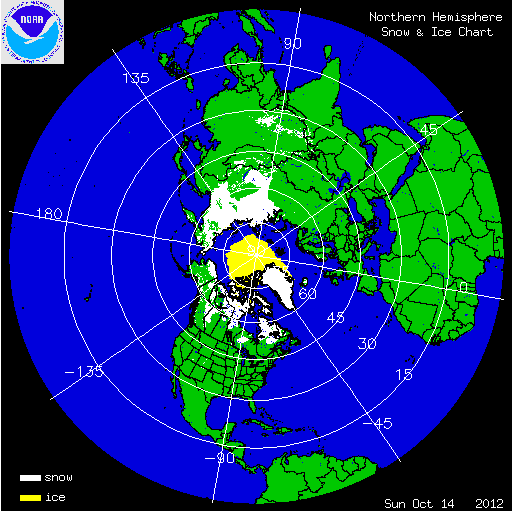Glaciers cracking in the presence of carbon dioxide
 |
| Northern Hemisphere snow and ice map , October 14, 2012 (credit: NSIDC, NOAA) |
Snow covers more than 33% of lands north of the equator from November to April, reaching 49% coverage in January. The role of snow in the climate system includes strong positive feedbacks related to albedo and other, weaker feedbacks related to moisture storage, latent heat and insulation of the underlying surface, which vary with latitude and season (IPCC, 2007a8).
 |
| Albedo or reflectivity of surfaces wikipedia.org/wiki/Albedo |
Snow and ice on the Northern Hemisphere has a cooling effect of 3.3 watts per square meter, peaking in May at ~ 9 watts per square meter. Snow and ice on the Northern Hemisphere has declined over the years and is now reflecting 0.45 watts less energy per square meter than it did in 1979 (Flanner, 2011). As discussed in Albedo change in the Arctic, this compares to warming of 1.66 watts per square meter for the net emission by people (IPCC, 2007b9).
A recent press release7 announced that researchers from the Massachusetts Institute for Technology have shown that the material strength and fracture toughness of ice are decreased significantly under increasing concentrations of carbon dioxide molecules, making ice more fragile and making ice caps and glaciers more vulnerable to cracking and splitting into pieces.
“If ice caps and glaciers were to continue to crack and break into pieces, their surface area that is exposed to air would be significantly increased, which could lead to accelerated melting and much reduced coverage area on the Earth,” said lead author of the study Professor Markus Buehler.
Buehler, along with his student and co-author of the paper, Zhao Qin, used a series of atomisticlevel computer simulations to analyse the dynamics of molecules to investigate the role of carbon dioxide molecules in ice fracturing, and found that carbon dioxide exposure causes ice to break more easily.
Notably, the decreased ice strength is not merely caused by material defects induced by carbon dioxide bubbles, but rather by the fact that the strength of hydrogen bonds—the chemical bonds between water molecules in an ice crystal—is decreased under increasing concentrations of carbon dioxide. This is because the added carbon dioxide competes with the water molecules connected in the ice crystal.
It was shown that carbon dioxide molecules first adhere to the crack boundary of ice by forming a bond with the hydrogen atoms and then migrate through the ice in a flipping motion along the crack boundary towards the crack tip.
The carbon dioxide molecules accumulate at the crack tip and constantly attack the water molecules by trying to bond to them. This leaves broken bonds behind and increases the brittleness of the ice on a macroscopic scale7.
A drop of as little as 1% in Earth’s albedo corresponds with a warming roughly equal to the effect of doubling the amount of carbon dioxide in the atmosphere, which would cause Earth to retain an additional 3.4 watts of energy for every square meter of surface area (NASA, 200510; Flanner et al., 2011b6).
Below, a video by Dr. Peter Carter4, showing loss of snow and ice albedo on the Northern Hemisphere from 1997 to 2009, using NOAA images, and also showing the relationship to global food security and Arctic methane.
Sources:
- Albedo - Wikipedia
wikipedia.org/wiki/Albedo - Albedo change in the Arctic
arctic-news.blogspot.com/2012/07/albedo-change-in-arctic.html - Carbon dioxide enhances fragility of ice crystals
by Zhao Qin and Markus J Buehler 2012
Journal of Physics D: Applied Physics Volume 45 Number 44
iopscience.iop.org/0022-3727/45/44/445302 - Carter, P., Northern hemisphere loss of snow and ice albedo cooling
youtube.com/watch?v=-18xi1hQXNc - Flanner et al. (2011a), Radiative forcing and albedo feedback from the Northern Hemisphere cryosphere between 1979 and 2008, Flanner et al.
nature.com/ngeo/journal/v4/n3/full/ngeo1062.html - Flanner et al. (2011b), Presentation October 27, 2011, WCRP Open Science Conference
wcrp-climate.org/conference2011/orals/B11/Flanner_B11.pdf - Glaciers Cracking - Press Release
cms.iopscience.iop.org/alfresco/d/d/workspace/SpacesStore/bf99f6c7-1386-11e2-bc48-4d5160a0f0b4/Glaciers_cracking_press_release - IPCC 2007a, Climate Change 2007: Working Group I: The Physical Science Basis
ipcc.ch/publications_and_data/ar4/wg1/en/ch4s4-1.html
ipcc.ch/publications_and_data/ar4/wg1/en/ch4s4-2.html - IPCC 2007b, Changes in Atmospheric Constituents and in Radiative Forcing, IPCC (2007)
ipcc.ch/pdf/assessment-report/ar4/wg1/ar4-wg1-chapter2.pdf - NASA, 2005 (at Archive.org)
archive.org/details/albedo_ceres_mar05 - NSIDC, NOAA - Northern Hemisphere snow and ice map
nsidc.org/data/g02156.html








